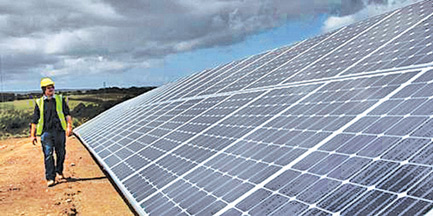Breakthrough in solar cells will provide cheap energy
Technical
advance based on edible salt overcomes need to use toxic agents
A breakthrough in the production of solar cells will make the next
generation of solar panels cheaper and safer, and promises to accelerate
the development of solar energy over the next decade, scientists said.
A technical advance based on an edible salt used in the manufacture
of tofu could revolutionise the production of future solar panels to
make them less expensive, more flexible and easier to use than the
current models seen on roofs.
|

Making and maintaining solar panels will soon be cheaper
than fossil fuels |
Researchers believe they have found a way of overcoming one of the
most serious limitations of the next generation of solar panels, which
are based on toxic cadmium chloride, by simply adding magnesium
chloride, an abundant salt found in seawater.
A study has shown that the solar cells produced with magnesium
chloride - which is also found in bath salts as well as used to
coagulate soya milk into tofu - work just as efficiently as conventional
cadmium cells but at a fraction of the cost and with much lower
toxicity.
"Magnesium chloride is incredibly low-cost and it's simply recovered
from seawater. It's used to de-ice roads in winter and it's completely
harmless and non-toxic. We've managed to replace a highly expensive,
toxic material with one that's completely benign and low cost," Dr Major
said.
About 90 percent of the solar panels currently in use are made of
photovoltaic cells composed of silicon semiconductors, which convert
sunlight directly into electricity.
However, silicon is not good at absorbing sunlight which is why the
next generation of PV cells will be based on a thin coating of cadmium
telluride, which absorbs sunlight so well that it only needs to be about
one hundredth of the thickness of silicon.
However, although cadmium telluride is seen as the future for solar
energy, it is potentially dangerous after it is "activated" with cadmium
chloride, a critical step in the manufacturing process that raises the
efficiency of converting sunlight to electricity from about two per cent
to 15 percent or more.
The Liverpool team attempted to find an alternative to cadmium
chloride in the activation step and discovered that it could be done
just as well with magnesium chloride, which they sprayed onto a test
sample of cadmium telluride with a model aircraft spray gun they bought
for £49.99, Dr Major said.
In a study, the researchers demonstrated that the efficiency of the
resulting photovoltaic cells made from cadmium telluride and magnesium
chloride were on a par with commercial cadmium telluride cells that had
been activated with toxic cadmium chloride.
- The Independent |

